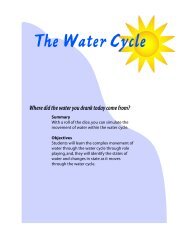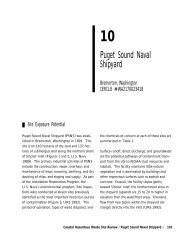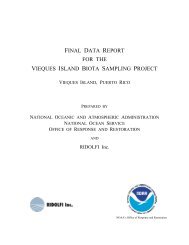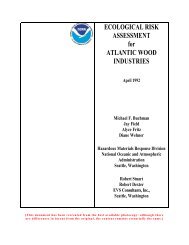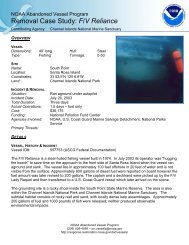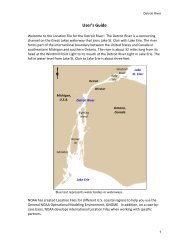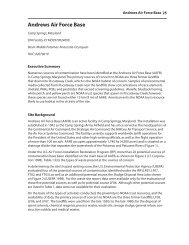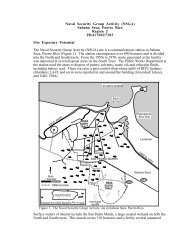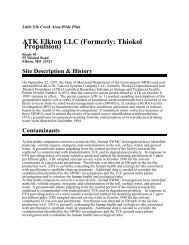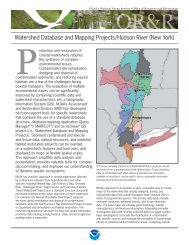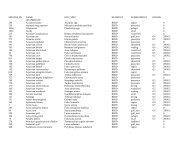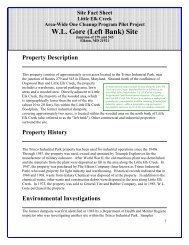The Coastal Resource Coordinator's Bioassessment Manual
The Coastal Resource Coordinator's Bioassessment Manual
The Coastal Resource Coordinator's Bioassessment Manual
Create successful ePaper yourself
Turn your PDF publications into a flip-book with our unique Google optimized e-Paper software.
HAZMAT 93-1–Toxicity Tests<br />
contaminants. <strong>The</strong> Microtox ® test was determined to be the most cost effective. <strong>The</strong> use of<br />
two amphipod species (Rhepoxynius and Eohaustorius) and the measurement of<br />
developmental abnormalities in echinoderms (Dendraster) were determined to be<br />
moderately cost effective. Tests using polychaetes (Neanthes) and geoduck clams (Panope)<br />
were determined to be the least cost effective.<br />
Although cost can be an important factor in the selection of toxicity tests, it should not be<br />
the primary criterion. Ideal tests should have high discriminatory power, low withinsample<br />
variability, and strong positive correlation with measured concentrations of<br />
contaminants (Long et al., 1990). Although the Microtox ® test is relatively inexpensive and<br />
may be very sensitive to some contaminants, this does not necessarily make it the test of<br />
choice for all situations.<br />
SAMPLING DESIGN CONSIDERATIONS<br />
Designing a sampling plan for toxicity testing should be done in conjunction with a<br />
chemical analysis sampling plan. Ideally the samples to be used for chemical analysis<br />
should be split (subsampled) with one portion being chemically analyzed and the other<br />
portion being used for toxicity testing. At the very least samples for chemical analysis and<br />
toxicity testing must be taken at the same time and location. Without this conjunctive<br />
sampling it would be impossible to correlate toxicity to contaminant concentrations.<br />
Another consideration when designing a sampling plan is the holding time for samples; for<br />
example, the time between sample collection and the beginning of the toxicity test. Many<br />
chemical and toxicity test protocols specify maximum holding times for environmental test<br />
samples in order to insure that the properties of the sample do not significantly change<br />
between sampling and analysis. For example, the prolonged storage or exposure to air of<br />
sediment samples will volatilize acid volatile sulfides (AVS) thus increasing the availability<br />
and toxicity of metals which are normally bound to AVS. However, the exact implications<br />
of exceedances of holding times are unknown for most chemicals. Resident infauna in<br />
sediments will eventually die, decay, and may produce lethal levels of ammonia. Bacteria<br />
present in the sample may continue to alter contaminants such as PAHs. Mercury for<br />
example, is thought to change more quickly than other metals. Since the different forms of<br />
many metals vary in toxicity, the response to test samples might change if holding times are<br />
exceeded. A basic rule of thumb is not to exceed holding times of two weeks for sediment<br />
toxicity tests when the samples are maintained at 4 degrees Celsius. While sediments for<br />
3-11 August 1997



